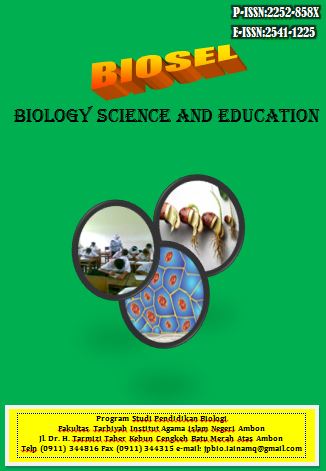Effect of Tongka Langit Banana-Based Supplementary Feeding on β-Carotene Contents of Apis cerana (F.) Bee Honey
DOI:
https://doi.org/10.33477/bs.v14i1.7767Abstract
Suplementary feed based on the flesh of tongka langit bananas has never been done, even though tongka langit bananas are very qualified as supplementary feed because there is 55% glucose as a substitute for nectar and other similar ingredients and the presence of β-carotene in these bananas as a precursor of vitamin A which is expected to be present in honey when given additional feed based on tongka langit banana. This study aims to determine the effect of giving tongka langit banana-based supplementary feed on the β-carotene content of Apis cerana (F.) bee honey. The research method used was experimental with a Completely Randomized Design at the A. cerana bee farm to obtain data related to feed consumption in four treatments located in Eri Village, Nusaniwe District, Ambon City, Maluku. Then the composition of honey in the form of β-Carotene and vitamin C was further analyzed using the KCKT method of normal phase chromatography (normal phase chromatography) related to the concentration of the four treatments at the Laboratory of the Bogor Agricultural Postharvest Research and Development Center. The results of the analysis of β-carotene content using the HPLC method showed that the highest β-carotene content was in the tongka langit banana feed of 2.275 mg/100g followed by fresh ripe tongka langit bananas of 2.198 mg/100g while in the water + sugar diet it was 2.075 mg/100g and natural feed without treatment as the lowest β-carotene content, namely 1.975 mg/100g.
Keywords: Apis cerana, Tongka Langit Banana, Honey, β-Carotene, HPLC
Downloads
Published
Issue
Section
License

This work is licensed under a Creative Commons Attribution-NonCommercial 4.0 International License.
Authors who publish with this journal agree to the following terms: Authors retain copyright and grant the journal right of first publication with the work simultaneously licensed under a Creative Commons Attribution License that allows others to share the work with an acknowledgement of the work's authorship and initial publication in this journal. Authors are able to enter into separate, additional contractual arrangements for the non-exclusive distribution of the journal's published version of the work (e.g., post it to an institutional repository or publish it in a book), with an acknowledgement of its initial publication in this journal. Authors are permitted and encouraged to post their work online (e.g., in institutional repositories or on their website) prior to and during the submission process, as it can lead to productive exchanges, as well as earlier and greater citation of published work.













